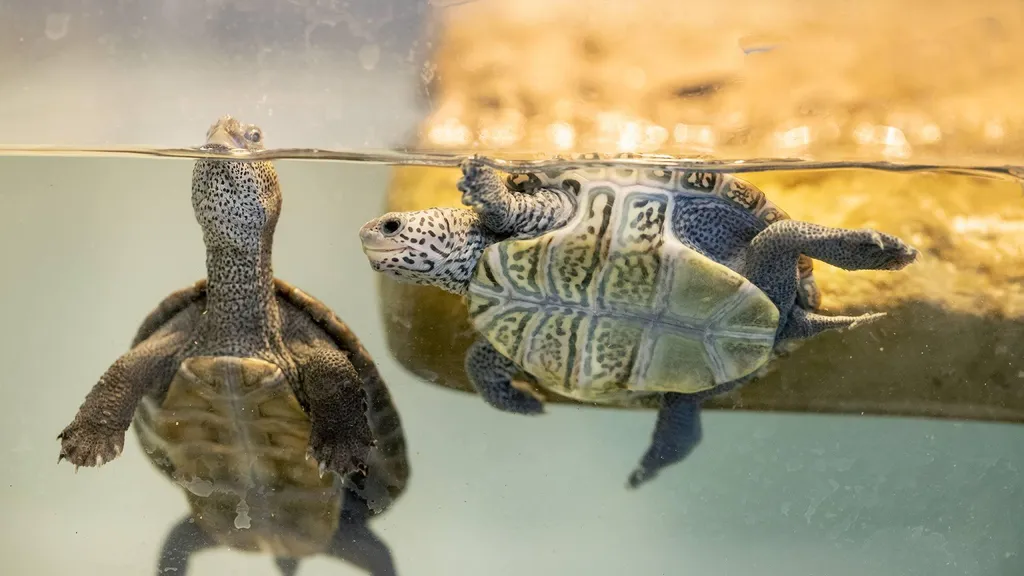- December 05, 2022
- By Karen Shih ’09
University of Maryland students are accustomed to seeing larger-than-life Testudos, whether bronze statues or furry mascots. Now a few Terrapins are holding real terrapins, and finding they fit in the palm of their hands—though they’re not content to stay there.
The walnut-sized hatchlings are incredibly squirmy and dexterous, as Lauren Taylor ’23 demonstrated in class last week, carefully lowering one into a plastic tub on its back. Before she could even remove her hands from the container, the tiny terp flipped right-side up again.
“They have really long and strong necks so they can turn themselves over,” she said.
That’s one vivid example of the physical adaptations that terrapins have developed to survive and thrive in the turbulent coastal waterways they calls home. Elementary education majors had their lesson brought to life with the help of three diamondback terrapins that are being raised in a tank at the College of Education for the 2022-23 school year.

“It’s one thing to teach and learn about something like adaptation in the abstract,” said instructor Amy Green, director of the Center for Science and Technology in Education. “But it’s another to have the turtle in front of you, to hold them and feel how strong their legs are. It’s an adaptation that makes them fit for swimming in the tidal waters of the Chesapeake estuaries.”
Green and Assistant Clinical Professor Angela Stoltz are co-raising the terrapins from the Terrapin Education Research Partnership (TERP), a program that gives educators across the state opportunities to use turtles in their classrooms for a school year, supporting the healthy growth of the young turtles as well as the environmental literacy of students. Willem Roosenburg, an Ohio State professor who has been monitoring diamondback terrapins on Poplar Island in the Chesapeake Bay for the last two decades, collects eggs each summer under a Maryland Department of Natural Resources permit and incubates them, then distributes them once they hatch. (Predators often seek out nests and young turtles, so the program gives them a chance to grow bigger and stronger before being released into the bay.)
A speaker from the Maryland Environmental Service, another partner in the TERP program, brought turtles to a course that Green taught last spring for the M.Ed. STEM Teacher Leadership program. She and Stoltz then decided to apply, and this fall, brought the three little terps to campus. They set up tanks both on campus and at home so that they can care for them during academic breaks.
“The TERP program has a lot of data on the impact of the classroom program on the turtles, but didn’t have a sense of how it was impacting the student and teacher experience,” said Green. Now, she and Stoltz are developing curricula and assessing the impact of incorporating the terrapins into the classroom on the teachers in training.
Throughout the semester, student volunteers have been collecting measurement and weight data. Last week, Green brought them into the classroom for the first time for her science methods course, where students handled the hatchlings to better understand their behavior and traits. This week, the students are delving into the historical role of turtles in Indigenous communities, such as creation stories about turtles carrying the world on their backs.
“What are the structures and behaviors of the turtle that might have led to native people assigning them that role and responsibility?” Stoltz said. “We’re bringing in non-Westernized perspectives into the classroom, exposing them to these ideas of relationships with and responsibility to the natural world.”
In the spring, she will incorporate the turtles into her master’s-level course on innovation in math education. Once the school year ends, she and Green—and any students who want to join in—will return the terrapins to Poplar Island off the Eastern Shore of the Chesapeake Bay, where they were born.
“We are ‘EdTerps,’ and here are these terps educating us,” said Green, who plans to apply again next year. “They’re so engaging and they’re a really powerful tool for learning, as well as an inspiration.”
See the Baby Terps (And Help Name Them!)
Want to see the hatchlings? They’ll be on display in Room 2311 of the Benjamin Building in the Department of Teaching and Learning, Policy and Leadership office today and tomorrow! You can also vote until Wednesday to help name the trio.
For faculty members who are interested in using the terrapins in class, contact Amy Green (amygreen@umd.edu) or Angela Stoltz (astoltz@umd.edu) to arrange a visit.
“This is the pilot year, so we are trying to see the different ways we can engage our students and staff in learning in and around these guys,” said Green.
Topics
Campus & CommunityTags
Student ExperienceUnits
College of Education